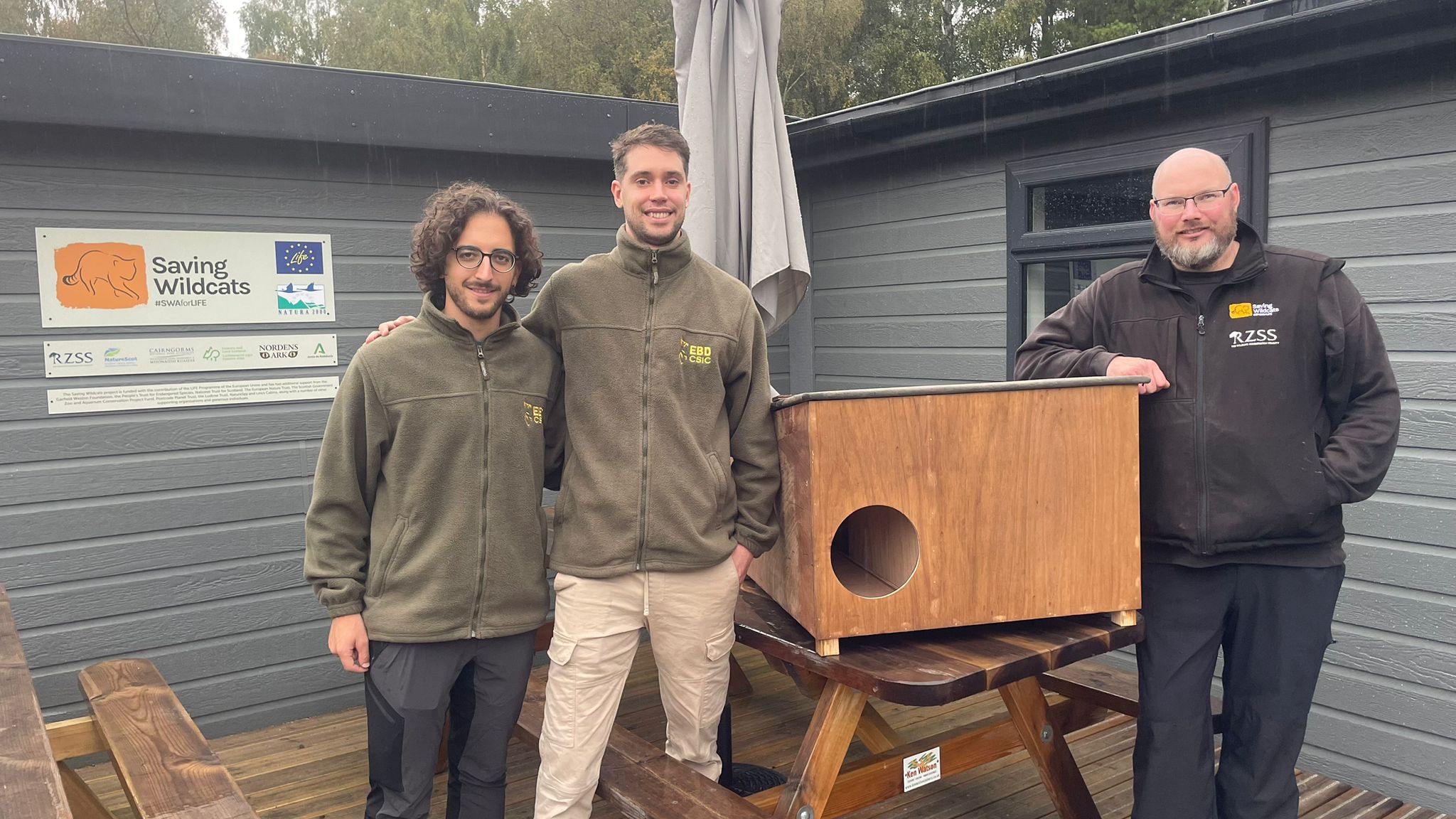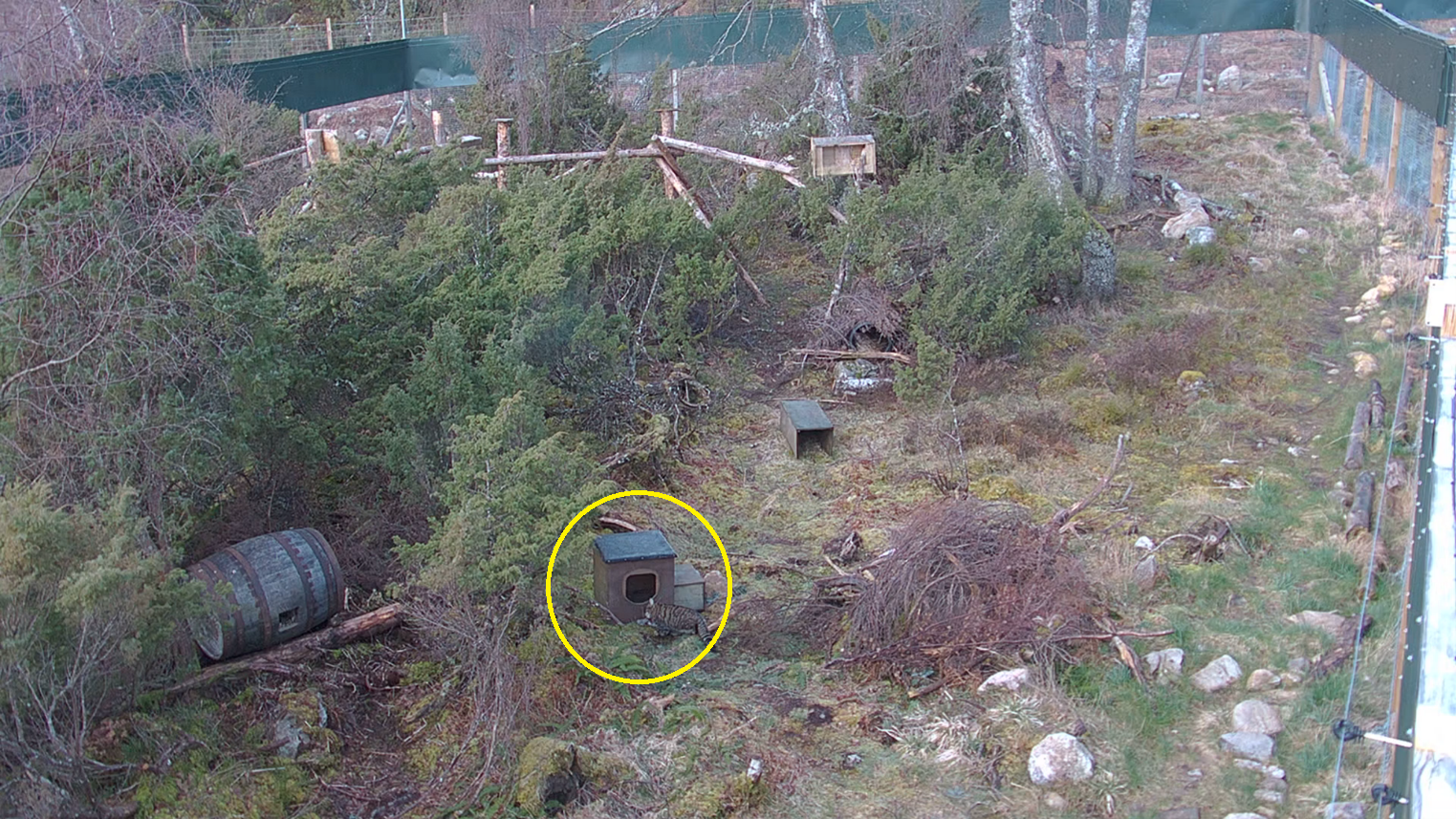Monitoring wildcat health using remote weighing scales
The Saving Wildcats Conservation Breeding for Release Centre (CBRC) is a critical component for the successful release and recovery of wildcats into Scotland. Situated at in a remote location within the Royal Zoological Society of Scotland’s Highland Wildlife Park, it provides the perfect environment and resources for the breeding and pre-release management of wildcats, giving them the best chances of survival once released. We refer to the ex-situ management approach for cats within the CBRC as 'hands off management', which relates to our objective of minimising disturbance and activity in and around the enclosures to ensure the cats do not become habituated to human presence, so that they do not seek humans out once released. This is achieved through various means including, but not limited to, the use of quiet electric vehicles, no public or guest access and remote CCTV monitoring.
Whilst this is all beneficial for the cats' pre-release development it does pose one challenge regarding how we continue to ensure the highest standards of animal welfare and health monitoring when we need to limit our presence around them. Although our remote CCTV monitoring system is an incredible tool and allows us to remotely monitor key behaviours and check the physical condition of cats daily, it can’t give us all the data we need to support ongoing health monitoring.
One example of this is weight monitoring of the cats. Weight data is valuable information for animal management as it contributes to general health assessments, improved knowledge on seasonal fluctuations and, at times, the increases or decreases in diet provision.
This is not only true for health monitoring of wildcats that are managed in the CBRC but also, and perhaps more importantly, for the cats that have been released into the wild. For traditional animal management (i.e. where close working with the animals is beneficial) other techniques are used to support weight recording e.g. training animals to stand on scales, however this would be counterproductive when preparing animals for release and would increase habituation to humans and not decrease it. There are also various weighing scales that are used for animal management but unfortunately none, at least to our knowledge, that would meet our specific needs for 'hands off management' of our wildcats, which include:
- Full outdoor use (i.e. waterproof, cold and hot weatherproof)
- Data logger including date and time (e.g. via USB or SD card)
- Cat proof (i.e. resistant from biting and scratching)
- Easy clean for disinfecting between enclosures
- Possibility for individual identification (RFID reader)
- Autonomous with good battery life (i.e. can be left in enclosure for several days)
Our quest to find such a system was not an easy one. Quickly the idea of buying a commercially available off the shelf unit was rejected following extensive testing of potential systems and a lot of research. This meant that we had to explore our innovative side and hope that we could find a team that could develop a custom built prototype system that met all of our needs.
After further research (and many emails) from our ex-situ manager we managed to engage with a fantastic team at the University of Seville (Spain), led by Professor Jorge Fernández-Berni, specialist in smart conservation technologies. Over a two year period involving visits to Scotland, multiple online meetings and continuous design and testing we finally managed to develop our wildcat remote weighing system.

The system can be adapted to fit in both our wildcat nest boxes and in our purpose built (mobile) weighing boxes, that can be used at ground level or raised as an elevated den box. The system includes a removable battery for remote charging and replacement, an SD card slot for quick and easy access to data, easy clean components for disinfecting, robust metal weighing platform and a fully integrated data management dashboard where we can easily upload and analyse the data.


Since 2023 our new 'smart' remote weighing scale system has become a critical tool in our ex-situ management of wildcats. Initially, we trialled its use within our breeding enclosures before expanding the use of the system into our pre-release enclosures, allowing us to successfully weigh all 18 of the wildcats eligible for release in 2024, prior to release, with minimal disturbance.
Weight factors heavily into the final veterinary assessment prior to release. By having more regular weights for the cats, we can more accurately determine body condition and adapt diets and management early to maximise their chances of release.
This system has allowed us to collect the valuable data we need whilst still minimising our presence in and around the enclosure, leaving the wildcats to exhibit their natural behaviour away from human disturbances.
Following the successes of the remote weighing system within our CBRC it soon became clear that it could be possible to use the system in the wild (in-situ) where we were releasing cats, to support their ongoing health monitoring.
This would possibly be the first time an autonomous and remote weighing system would be used to monitor wild living felids.
As a result it was an exciting time for the team. After the first nine wildcats of 2024 were released in summer, the field team wanted to monitor their wellbeing and body condition to understand better how they were adapting to life in the wild.
Although this can be done to a certain extent with camera trap videos, weighing a cat to detect changes is the gold standard. It’s important to remember, just like with people, some cats are just generally bigger and heavier than others. Therefore, change over time with the same individual is the most accurate way of monitoring wellbeing.
Given the wildcats were used to using the boxes in their pre-release enclosures, we were optimistic that the cats would use them in the wild if they came across them. Although the boxes are mobile, they are still quite heavy (ranging from 20kg – 40kg) so we were fairly limited by where we could put the boxes and which cats we could target for weighing.
We focused our efforts on a male Caorunn, a female Eigg and another female Harris to begin with, to great success. We positioned the boxes along routes they were using regularly, which we were able to ascertain from their GPS-radio collars. The boxes were baited with food, encouraging the wildcats to enter them.
In fact, Eigg loved being inside the box so much, that she spent quite a lot of time chilling in there, even without the draw of food! We were pleased to find that she weighed 4.1kg, a healthy weight. We weighed her several times over a week to be sure the box was working properly.
We next used the weigh box to monitor one of the wildcats that was released in summer 2023, named Rummy. We weighed him in January 2024 when he was trapped to refit his GPS-radio collar, and it’s very interesting to how he is maturing into a big male. Rummy weighed 3.4kg in June 2023, 5kg in January 2024 and 4.9kg in July 2024.
Overall, using these remote weighing scales was a great method of monitoring the wild-living wildcats the first few months after release. These scales helped us to assess how the wildcats were adapting to the challenges of life in the wild and allowed us to see if supplementary food needed to be provided for cats who may have lost weight. Given the successes of this approach, we are likely to use these remote scales many times in the future.
We have been delighted with the collaboration with our colleagues in Spain and impressed with the results we have achieved so far. When combined with our CCTV monitoring system for wildcats that we use in our CBRC, there is no doubt that our remote weighing system will continue to be a critical tool for wildcat management.
When asked about the journey with the Saving Wildcats project Professor Jorge Fernández-Berni from the University of Seville said 'It's really exciting to see how the systems we have researched and developed in the last few years at University of Seville are becoming useful tools for specialists in the field of biodiversity conservation. We are strongly committed to strengthening this collaboration with the Saving Wildcats project by exploring new solutions for animal monitoring based on the latest scientific and technological advances.'

